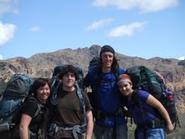
As the variably extreme (and predominantly unpleasant) second-semester weather on campus reached a crescendo in mid-March, the Hamilton Outing Club sent south four rugged adventurers to explore the half-rock, half-cacti world of the Superstition Wilderness in central Arizona. HOC officer Anna Bastidas ’13, HOC member Adam Fix ’13, and myself, official HOC journalist, with tireless leader Jeannie Folan ‘12, camped five nights and hiked five days through the wilderness, which makes up part of Arizona’s Tonto National Forest.
There are a lot of things to worry about in a place like Tonto—only eight or so inches of rain fall per year and the winds coming from the West are dry. Moreover, the sun in Phoenix is hot—very hot—and shade during the day is hard to find. Considering its climate, remoteness, lack of trail markers, and its many things that poke at you, Superstition Wilderness can seem to be an unfriendly place to visit.
There is definitely something to be said for roughing it in extreme conditions. We wandered down a practically trailless canyon for an afternoon, filtered puddle water (when we could find it) through bandanas, consumed more than four pounds of cheese, and once stood immobilized for 15 minutes because mean Mr. Rattlesnake was sunning himself right where we needed to walk. In my head at least, extreme is a term that is wedded to awesome, so harsh living conditions are exciting as a challenge.
But even those to whom roughing it is unpleasant would find Superstition Wilderness incredible. The landscape is mountainous on a smaller and more severe scale than in the Northeast. Steeply undulating hills are broken by jagged outcroppings of red rock. Everything seems to be sand-colored, and great armies of saguaro cacti perch on hillsides among small, angry-looking shrubs. The views will knock you over and seem to change dramatically, all-of-a-sudden, as the trail rounds a corner or comes up over a ridge. The most recognizable landmark in the wilderness is Weaver’s Needle, the enormous bare rock that was filmed in the movie Holes as the God’s thumb rock.
The trip began on Monday March 21, when all arrived in Phoenix, me by car and everyone else by air. While Anna and Adam were still en route, Jeannie and I did the grocery shopping, found a map, and dropped my car off at Peralta trailhead (we would hike to Peralta from a different trailhead and use my car to drive back to the rental car at the other trailhead). After picking up Anna and Adam, we camped for one night next to the car at Tortilla trailhead.
We hiked 11 miles that day and camped at Tortilla Pass. We spent Wednesday, Thursday, and Friday trekking between five and 10 miles a day, taking it easy and largely making it up as we went. Our route took us down unmarked Randolf Canyon, through Upper La Barge Box (a flat-topped mesa), over Bull Pass, and briefly through Boulder Canyon. On Saturday we saw the first human being we had seen in four days, and then immediately saw at least 100 more Phoenix day-hikers (who more than once referred to us as “heroes”) as we hiked over Freemont Saddle and down to my car.
Posted April 6, 2011
